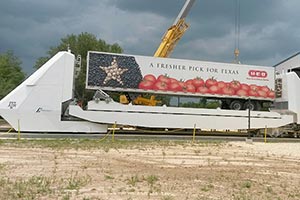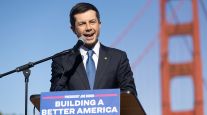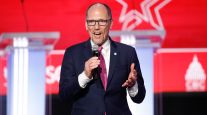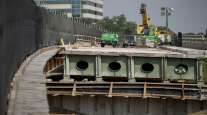Texas Officials Drafting Wish List for Potential Infrastructure Funding Windfall

Steve Costello — Houston's chief resilience officer, aka "flood czar" — needed less than a second to answer how to spend a $1 trillion investment in infrastructure for America.
"I would want about $3 billion for the city of Houston and Harris County for the bayous," he said.
Any Houstonian who has dried couch or car upholstery after a recent flood might easily agree, for what's becoming a part of living in some neighborhoods. Powerful, persistent storms the past two years soaked streets, stranded drivers who risked a high-water ride and lost. In some neighborhoods near bayous, the rains busted in, leaving behind waterlogged carpets and mud stains before receding back within the banks.
Ask engineers in Texas and, as the saying goes, everything is bigger here, including the needs and costs for new water pipes, locks and dams and roads and bridges. A plan to realign Interstate 45 in the Houston area alone is expected to cost about $7 billion, about the same as the lowest cost estimates for storm-surge protection for Galveston Bay.
RELATED: Houston Port shuttle hailed as potential freight-handling breakthrough
"Anybody can easily come up with a $1 billion or $5 billion way to spend on infrastructure, whatever amount you say," said Mike Voinis, Houston office leader for HNTB, a national engineering company. "There never is going to be enough money to handle all that, so we need to come up with innovative ways and creative ways to leverage the dollars we have. ... No amount of money can solve what we have."
President Trump and congressional Democrats have touted $1 trillion in infrastructure spending — a big goal that is gaining bipartisan support. But the ambition highlights the dramatic demands in Texas and across the country, as each state submits long wish lists to modernize roads, bridges, airports, river locks and yes, flood control.
"We are at this critical time where so much of the [infrastructure] stuff was built a long time ago," said David Ellis, an economist with the Texas A&M Transportation Institute. "We have not only got to continue to expand, but we have a lot of things we need to rebuild."
Nationally, the American Society of Civil Engineers estimates the country has $3.6 trillion in repair or improvement needs through 2020 and plans to spend $2 trillion, leaving a $1.6 trillion gap.
In 2013, in the most recent assessment, spread across hundreds of projects, the ASCE estimated Texas' wastewater improvement needs dwarf even those big price tags. There's $11.5 billion, at least, needed for sewers in the next 20 years.
RELATED: Houston manufacturers worried regional infrastructure not ready for impending cargo influx
Drinking water improvements, meanwhile, are tapped at a looming $33.9 billion.
Texas Wish List
With politicos in Washington at least talking about taking on some of that demand, Texas officials are drawing up a variety of infrastructure projects that either protect residents or boost local economies.
Projects such as Dallas' Cotton Belt commuter rail expansion, dredging of the Gulf Intercoastal Waterway, a new freight shuttle to carry goods across the El Paso border with Mexico speeding inspections and even a privately funded bullet train between Dallas and Houston are making their way onto lists of high-priority projects.
"There is a lot of talk about more investment and funding from the federal level, but we don't know a lot about that yet," Texas Transportation Commission member Jeff Austin said recently. "Depending on what the [Trump] administration does do, we have got to be ready."
Meanwhile, almost every state and local community in Texas is paying attention to what the infrastructure investment means to nuts and bolts projects like sewers, clean drinking water and even rural utilities.
The arithmetic of funding is constantly changing, said Craig Thompson, president of the ASCE Texas Section. Texas voters approved $2 billion in water infrastructure improvements in 2013 and a possible $3.5 billion in transportation funding in 2014 and 2015.
"That indicates to me an importance was placed on water and roadway infrastructure," Thompson said.
A major federal investment would cement that commitment but hardly eliminate it. There's no shortage of needs but also plenty of political considerations to moving that much money onto the streets of Texas, not to mention the bayous, water drains and ports.
"There is always going to be competition for federal dollars," Costello said. "Even region by region, you're competing."
Complex Process
Projects require extensive approvals and would face intense competition even with Washington lawmakers who would ultimately have to approve $1 trillion in spending.
Everything from environmental reviews to local matching funds to interested investors in private finance need to line up all the details before the first new bridge, flood control channel or even high-speed rail line is open for business.
How Congress would come up with the money and how it would flow to states remain unclear.
The Democrats' so-called "Blueprint to Rebuild America's Infrastructure," released Jan. 24, divided funding over a decade among a handful of infrastructure types, such as rebuilding roads and bridges, water and sewer improvements, new transit projects and even what Senate minority leadership called critical and innovative projects.
"Big, transformative projects that could catapult our economy frequently get left on the planning room floor, because of their size, complexity or cost," Democrats said in the 11-page blueprint. "We no longer build the world's tallest buildings, the world's fastest trains or the world's most efficient highway systems."
One potential project, which Treasury department officials identified in January as the Obama administration was preparing to leave office, was an automated electric freight shuttle for the border crossing between El Paso and Ciudad Juarez. The $1 billion project would create a freight cargo system on rails that could move freight cleared on both sides of the border, reducing congestion at the road border crossings.
The freight shuttle, developed by researchers at Texas A&M and also under consideration at the Port of Houston, bridges both Democrats' desire to innovate and Republican efforts to find projects capable of attracting private investment.
During the presidential campaign, Trump and his advisers circulated a plan to leverage bank financing to amass $1 trillion in U.S. infrastructure improvements.
A co-author of the plan, Wilbur Ross, is Trump's choice for commerce secretary and has argued for a "private-sector solution" to finding the money for needed improvements.
"Projects with strong and clearly defined cash flows are readily financeable in the capital markets," Ross and Peter Navarro, co-author of the plan, wrote.
Profitable Public Works
Flood control is perhaps Houston's most pressing infrastructure need, as powerful storms in the past two years have swamped the city. But local and state lawmakers struggle to fund some of the biggest flood control projects.
Costello said he can make the argument that drainage projects have an economic benefit, even if they don't provide a direct, steady revenue stream.
"If we can take land in the flood plain and protect it, then that land becomes useful for development," he said.
Houston makes a good case for the attention to otherwise mundane matters most people rarely consider. Nearly 7 million people reside in the metro area, and it is the capital of America's petrochemical industry. The same justification is used for a $6 billion storm-surge protection system in Galveston Bay.
Sure it's expensive, proponents say, but less expensive than replacing dozens of refineries and chemical plants if a hurricane threw the bay across the Port of Houston.
Dredging the entire intracoastal waterway was listed among the highest priorities of the Texas Freight Advisory Committee, led by Harris County Judge Ed Emmett. The channel was designed to be 125 feet wide and 12 feet deep along all 379 miles of Texas coastline, where it's essentially the boat highway between ports.
Consistent funding would make the waterway capable of handing more cargo, or the border more efficient, which helps spur business in the state, supporters have argued.
"It ultimately has an impact on the cost we pay for things," Ellis said.
Commitment to Commuters
Transportation officials make similar arguments to spur interest in highway projects, especially those along major truck routes such as Interstate 45 from Galveston to Dallas and Interstate 35, which connects Laredo, San Antonio, Austin and Dallas.
Two other Texas projects have been mentioned for major infrastructure spending — Dallas Area Rapid Transit's $1.1 billion Cotton Belt rail line expansion and the privately funded Texas Central Railway bullet train between Houston and Dallas.
The Cotton Belt line would give metroplex residents a 67-mile commuter line from northeast Dallas to southwest Fort Worth, with a key stop at Dallas-Fort Worth International Airport.
Texas Central, meanwhile, has even larger plans. The 230-mile high-speed rail line would make the trip between the two metros in 90 minutes, the company claims.
Bullet train officials said in a statement that they were pleased to be noted among the nation's most important infrastructure projects, but they reiterated that the project will be built with private money.
Voinis, who at the HNTB engineering firm has led projects across the infrastructure spectrum, said that, along with more potential public funding, meeting the immense needs in water, drainage and transportation also requires new considerations of what comes under the infrastructure umbrella.
"Everybody feels like government needs to do more to improve our infrastructure and quality of life," Voinis said. "But the challenge now is to look at things in a broader perspective, what kind of value you can get from spending, not just to address something today but how things might change. ... The thing we need to focus on is not pumping that money into projects that are going to just solve today's problems."




